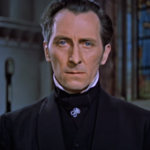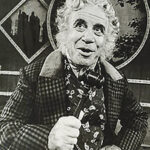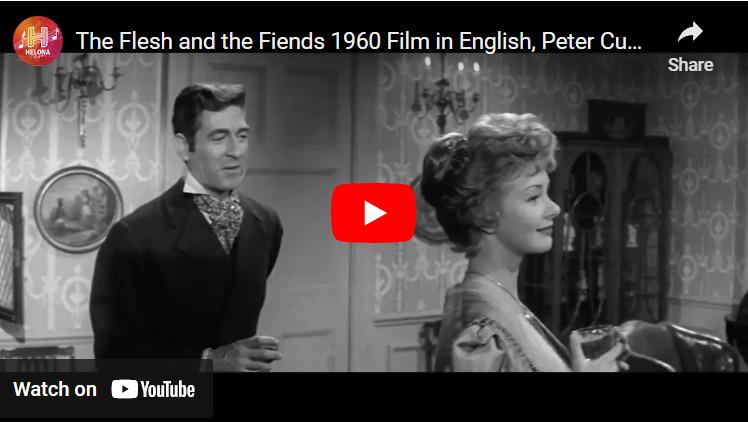
Here is another 1960s British Horror Film entitled The Flesh and the Fiends. The story and script were written by John Gilling, who also directed the movie. It stars Peter Cushing, Donald Pleasence and George Rose. There are probably other British stars that I don't recognize but these were the three main ones.
I have the link to the movie on YouTube posted at the end of this review where you can watch it for free like I did. However, in case it is no longer on YouTube, here is a link to it on JustWatch.com. You may need to put the title into the search box. This website keeps track of where you can see the video.
If you are a collector, you can purchase the Blu-ray on video on Amazon.
QUICK SUMMARY:
My main purpose is to discuss the movie in terms of how we, as writers and storytellers, can learn from these early movies. I'll give just a quick summary of the movie, just enough to reference the topics I'll touch on in this review.
The story takes place in the late 19th century in London. A scientist is obsessed with learning more about medicine and resorts to paying grave-diggers to bring him bodies so he can dissect them to learn more. He believes this a noble cause. The bodies originally delivered are dug up from the graveyard and sold as being "only three days old". They are covered in dirt and decomposition is already taking place. Dr. Knox pays four or five ginnies (slang for a 5 pound note) for them and is happy to have them.
One night, two town thugs find out that the doctor is willing to pay up to 6 ginnies for a dead body and they bring in a body they find that just died. Because the body is fresh and just recently dead, the doctor pays them 8 ginnies.
One of the criminal thugs owns a boarding home with his nagging wife and the two criminals begin 'helping a few deaths along' in one way or another and then sell it to Dr. Knox. The doctor remains in denial about it, even though his assistants try to tell him something is not right about so many fresh dead bodies turning up. Dr. Knox is blinded by his ambitions.
The movie is a moral tale (with no lecturing) about both the temptation of money and how it can bring men to the point of evil and a second moral tale of how allowing an obsession, albeit nobly intended, can progress to its own evil.
As a viewer and lover of gothic movies, I loved this movie. It had it all: From the gothic old London scenery to the interaction of the lower classes with the upper, it was really enjoyable.
 HOW THE HISTORICAL TIME AND PLACE ARE ESTABLISHED:
HOW THE HISTORICAL TIME AND PLACE ARE ESTABLISHED:
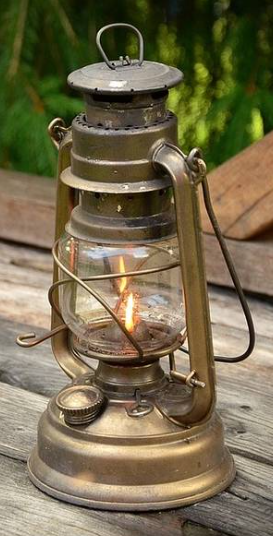 As soon as the movie starts, an information panel with the date is posted giving the viewer an exact time frame. It also gives you the name of Dr. Knox and tells you he's a scientist. The viewer is immediately anchored in the late 1800s when the story starts. Aside from this, the scene further anchors you in the 19th century by the fashion, the kerosene lights, the cobblestones, the scientific props and the dialogue.
As soon as the movie starts, an information panel with the date is posted giving the viewer an exact time frame. It also gives you the name of Dr. Knox and tells you he's a scientist. The viewer is immediately anchored in the late 1800s when the story starts. Aside from this, the scene further anchors you in the 19th century by the fashion, the kerosene lights, the cobblestones, the scientific props and the dialogue.
It is soon established that there is no means for doctors or scientists to get cadavers in this world of early scientific discovery. The scientists, at least Dr. Knox, resorts to paying gravediggers to dig up fresh bodies that he can experiment on. That lays the groundwork for the story that is about to unfold.
What makes Dr. Knox appear so noble is that he is also a professor of a room full of budding doctors. It's hard to hold the grave robbing against him in the beginning of the movie. He is helping so many people and passing this knowledge down to create other doctors to help people.
A MORAL TALE:
 What I love about the old movies in particular is that most of them were moral tales of one type of another. The scriptwriter and director had a point in presenting the story and it was almost always a moral point. Today, there are thousands of these 'a slice of a meaningless life with one glorified sin' movies that I abhor mainly because they are empty and pointless. So the fact that this story had a dual moral tale made it all the more enjoyable.
What I love about the old movies in particular is that most of them were moral tales of one type of another. The scriptwriter and director had a point in presenting the story and it was almost always a moral point. Today, there are thousands of these 'a slice of a meaningless life with one glorified sin' movies that I abhor mainly because they are empty and pointless. So the fact that this story had a dual moral tale made it all the more enjoyable.
ALL RICH CHARACTERS:
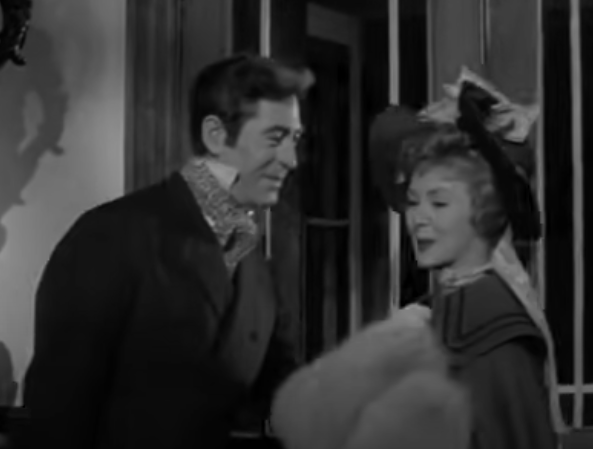 The characters are very "Charles Dickens like" almost to the point of being comical. An author can learn a lot about creating characters, especially ones who fit into a Charles Dickens type of story. The bad guy and bad girl characters were a little over the top -- but not too much. Just enough to make them colorful, enjoyable and watchable.
The characters are very "Charles Dickens like" almost to the point of being comical. An author can learn a lot about creating characters, especially ones who fit into a Charles Dickens type of story. The bad guy and bad girl characters were a little over the top -- but not too much. Just enough to make them colorful, enjoyable and watchable.
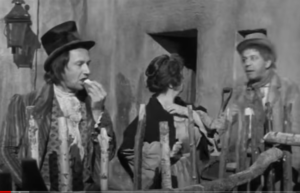 It's so helpful to also see how the set director arranged the backdrop of the scenes to add in historical elements, all of which enrich the story. For example, the cobblestones, the street gas lights, occasional hand-held torches, the mob with torches, even the archaic scientific lab. These all kept the story anchored in the time frame.
It's so helpful to also see how the set director arranged the backdrop of the scenes to add in historical elements, all of which enrich the story. For example, the cobblestones, the street gas lights, occasional hand-held torches, the mob with torches, even the archaic scientific lab. These all kept the story anchored in the time frame.

This is also a great move to watch to see how the scriptwriter and director portrayed the lower classes against the upper classes. For example, the thugs wore mismatched, wrinkled, and dirty clothes along with their top hats. The rich guys were all clean, crisp and tidy, including their white gloves and perfectly tied ascots. Even their posture allowed them to look slightly down their noses at everyone, including each other. The lower class men wore pants that were too long and baggy and suit jackets that were ill-fitting. I don't want to even tell you what their shoes looked like! These are all very subtle differences when you analyze them one at a time, but they all helped present the striking difference between how the upper and lower classes lived.
NUDITY IN THE 1960s:
This movie was shot in 1960s and, unlike most movies from this early on, there were two scenes where the female breasts were exposed. It wasn't excessive and it wasn't what I would refer to as gratuitous. The women were bar whores, so the naked breasts told that story in less than ten seconds. It was also a pleasure to see real female breasts instead of the silicone half-cantaloupes we see today in movies.
The scenes of the lower class took place in a brawling tavern or pub of some kind. So the crowd scenes were mainly a back drop for spotlighted action that book place in that environment, so it has a lot to teach a writer about that particular setup. How to describe a bawdy scene occurring in the background while casting a spotlight on a main character or two having important or at least relevant dialogue.
ALL THE GOTHIC TROPES:
If you're a fan of gothic movies, as I am, you will enjoy this one. The atmosphere that takes place in the shadows of the London nights in the alleyways, under the roman arch, the distressed cement and brick walls with the hanging gas lights is delicious.
They have a few graveyard scenes which is a classic gothic trope too. The subject matter of the story is macabre enough to hold your interest and just give you a tiny horror shiver without overdoing it.
CHARACTER ARCS:
The two main bad guys in the movie start out as general ne'er-do-wells that are always looking for a quick buck. Both actors did an amazing job at creating a colorful character without much backstory. These characters could have easily been paper-thin had it not been for the character actors who portrayed them.
Once they find out you can make eight ginnies for a dead body, suddenly, they descend into another level of criminality. And realistically, they go from level to level into full evil.
There was nothing redeemable about either character, but the acting made them both interesting enough to want to know what would happen to them. This is another great lesson for writers. You want a bad guy who the reader hates, but not enough to close the book on him!
A FEW LESSONS IN CONFLICT:

When I started out writing, I heard so many times about conflict, conflict, conflict. All stories had to have conflict. I originally thought that to portray conflict, you would need to make characters at such odds that they would at least spar in some way. But that's no so. The conflict can be more subtle and less emotional. This is a good movie to watch the conflict between the doctor and his assistants. There are two separate conflicts and there are subtle differences between each one.
The first conflict is a battle of moral wits that takes place between Dr. Knox and one of his employees. This is a good scene to watch to learn about lower-level conflict. As I learned along the way, a definitive difference of opinion on something can be enough to present conflict. The conflict between Dr. Knox and his assistant is a level 5 out of 10. It could even be described as a difference of opinion but Dr. Knox has the power of the employer behind him.
There is a secondary conflict that takes place later on in the story between Dr. Knox and the other doctors who confront him. This is more of a level seven conflict; and it could be described as more like a 'rich guy hissy fit'. There's no violence, but he tells them off but good. This is seen in many movies and you can see it here done very well. Peter Cushing does an amazing job with the tell off. This is also a conflict with a little bit of a power struggle as well.

For the new writers, I'll list below some of the things that help anchor a story in the 19th century and also anchor the story among the rich or the poor. This is a list I wish I had found early on in my writing career!
If you read this review before you watch the movie, you can see these items pop up throughout the film and see how they anchor the scene in the same historical time frame.
PROPS THAT SCREAM 19TH CENTURY SCIENCE:
1. Personal labs in the scientists house.
2. Hanging skeleton out of real bones
3. 19th century school room
4. Body called a stiff but corrected to a subject
5. Liquor poured from a glass carafe
6. Hand-held kerosine lanterns
7. Heavy, nagging wife with a shawl (always portrays the lower class)
8. References to 'the cupboard', peeling vegetables into a big bowl (lower class or servant class)
9. Water pitcher and big bowl in bedrooms
10. Men and women dancing at an arm's length in ballroom
11. Cobblestones, war-torn looking brick walls, roman brick arches, gas street lighting,
12. Town crier reading from a long scroll about "murder most foul" -- they are announcing there's been a stabbing murder. The people are all outraged and beginning to form a mob.
13. Mob rises up and storms into the streets
14. The noose around a bad buy's neck with a priest alongside for last rights
15. Hand-held kerosene lanterns
16. Village mob justice
OLD WORLD ENGLISH FASHIONS:
Hats - Top hats, fancy hats for upper class, sleeping cap like hats for the lower class
Long dresses, lots of layers - servants usually have an apron over their dresses
Muff to keep the hands warm while riding in the horse drawn carriages
Scarfs tied into bows for ascots
Globe gas lights among the rich
Suits with vests
PORTRAYING THE POOR:
Clothing is mismatched, rumpled, dirty, and torn
Messy and/or overgrown hair.
Women with balding issues or long straggly hair
Old worn-out shoes
Stick as a cane
RICH PEOPLE:
Scenes are always shot in more light
Estate homes
Expensive oil paintings
Clocks
Men are dressed in crisp suits, well fitting with stiff 'ironed' collars
Ruffled shirts (historical pictures)
Formal settings even the men wear white gloves
Men smoking cigars and pipes
Ultra straight posture, almost looking down their noses

CONCLUSION:
This is a great movie to watch when you're in the mood for an old world Gothic flick. It's also a great choice for new authors and writers to learn about historical settings, anchoring each scene in it's time, and how to portray a moral tale. This is a good move to see how to present the rich against the poor.
Very often the movies I watch are posted by regular people and they are then taken down by YouTube. So I will post the free YouTube video below. If it's no longer there, you can find it at the links I posted at the beginning of this review.
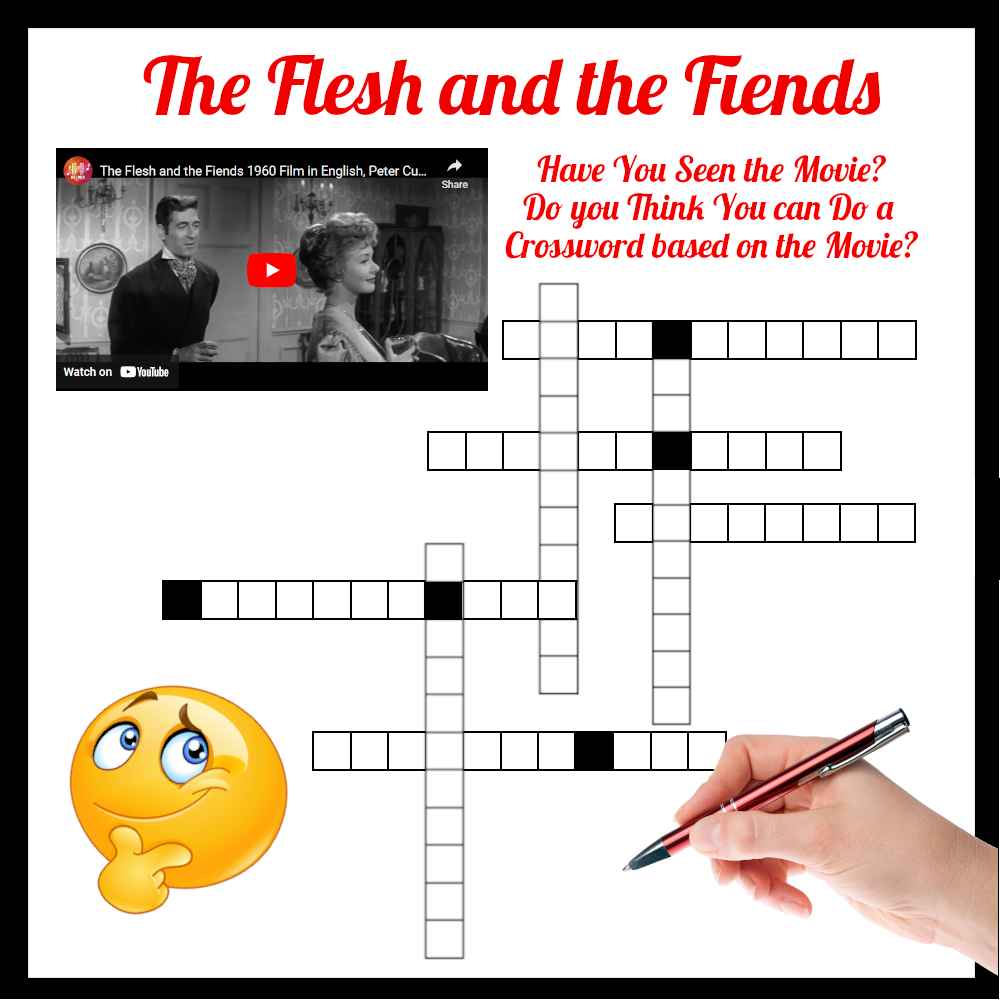
To do the crossword online, click here
To download crossword with answers from Google Drive, click here.

